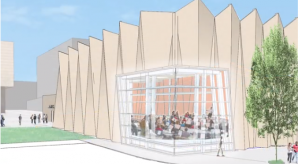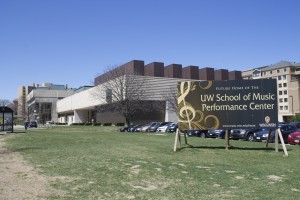by Elise Romas
Music and Performance majors at the University of Wisconsin-Madison will have more room to expand their creativity after the construction of a new campus building.
They will have the opportunity to echo melodic tunes through the new establishment next to the Chazen Museum of Art at the corner of Lake Street and University Avenue in the coming future.
The $22 million building will contain approximately a 325-seat recital hall, a large rehearsal room and a spacious lobby, UW news sources say. However, employees and students of the music department say that the new building will also serve its purpose towards the greater Madison community.
“It will be another way for us to continue to be engaging with our audiences within the state,” Susan Cook, UW Professor of Musicology and School of Music Director, said. “So there will be a way for us to be inviting people in.”
Part of this engagement process is the unique characteristic of a glass corner window exposing a rehearsal hall on one of the far sides of the new building, facing the Chazen.

Cook says that the corner glass window is a strategic element for grabbing the attention of those out on the street. By showing people what is going on in the rehearsal building, people are more inclined to gravitate towards the concerts that may follow. Cook went on to say that she thinks that showing people what is going on inside the new building will also expand the knowledge and creativity of what is done at the UW-Madison School of Music.
University of Wisconsin-Madison Letters and Science Dean John Karl Scholz expressed a similar standpoint as Cook on the new music hall. He said that it is going to be a visual magnet for those passing by.
“Any visitor [who] travels down University Avenue is going to see this gorgeous architecture and be drawn into it.” Scholz said. “I think it will draw people, not only from Madison and Dane County, but from around the state and beyond.”
The current music performance and learning space for students, the Mosse Humanities Building, has been the home of the music school for the last 46 years. A building that is nearly a half of a century old raises a few safety concerns for those who visit it daily. Cook is even more convinced that students need a new, larger and up-to-date rehearsal space due to some of these concerns
“Brass instruments produce a lot of energy, and if there’s not a lot of space for that energy to go into then we’re potentially damaging students’ ears,” she said. “So I’ve become more aware of the health and safety issues of having a space that’s big enough to actually take in that energy.”
Due to these worries among many other reasons, the outdated building will be replaced.

The recital hall and rehearsal room are only part of phase one out of a three-phase project. The first two phases are the performance space phases. This means that the smaller 325-seat recital hall that will hold smaller ensembles, while the second phase will contain a bigger performance area housing over 700 audience members. Lastly, phase three is a building that will contain classrooms.
However, it will not happen overnight.
Specific groundbreaking dates are uncertain right now, but Cook says that they hope to begin about a year from right now. Optimistically speaking, she says the entire construction of phase one will take about 18-22 months.
Cook hopes that when the university sees the product of the first phase of the project that it will decide to help supply some of its own funding into the final two phases. As for right now, the new music performance center relies solely on fundraising and the support of their generous donors.
Since the university does not directly fund the construction for the new building, Cook says that the recent budget cuts don’t necessarily affect it directly. She said that there is a chance that the cuts could have a sideways effect, if any effect at all.
“I could imagine it’s just going to mean that if other parts of the university don’t have the staff to keep everything moving things forward, it’s just going to take longer to do things,” she said. “Everybody will be doing more with less.”
A UW news report from December said that the building is named after a few of its most generous donors. University of Wisconsin-Madison alumni Pamela and George Hamel, a couple which donated $15 million towards the construction of the building, will have the music building named after them.
According to Professor Michael Leckrone, the Hamel Music Center

Photo courtesy of Jeff Miller
will act as a portal between the UW-Madison School of Music and the surrounding Madison community. The performance space will help provide the knowledge of where the performances are held.
Professor Leckrone has been a band director since the first year the Mosse Humanities Building opened. He expressed that the new performance space with its modern implementations will do a better job of grasping the attention of the campus population and the greater community area due to its location and outward visual appeal.
“There’s a convenience factor, that students who might not go to a musical performance [will] see it there,” Leckrone said. “It’s more natural. [It’s more like], ‘Oh I’m going to see what’s going on there,’ as opposed to, ‘I don’t know where this concert hall is’.”
The current concert hall, Mills Concert Hall, is located in what Leckrone referred to as the ‘bowels of Humanities’. With so much concrete surrounding one of the largest performance spaces on campus, it is difficult for people to locate. With the new building, with a corner window showcasing the rehearsal room, there is no way anyone could miss it.
Branching out and spreading the knowledge of what the UW School of Music as well as the university as a whole have taught and accomplished is very important to those who work within the music program as well as the school. It is something unique that UW takes to a new level.
“We have a remarkable university here, and I think one of the things that is very special about the place is commitment that people have the municipal benefits that extend beyond the walls of the campus,” Scholz said.
For more on this topic, click here.
